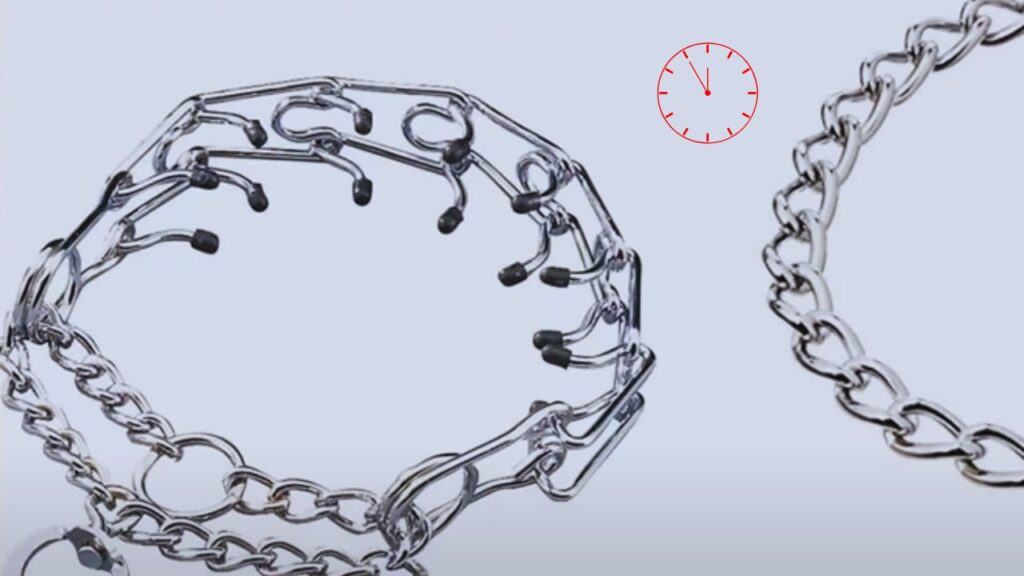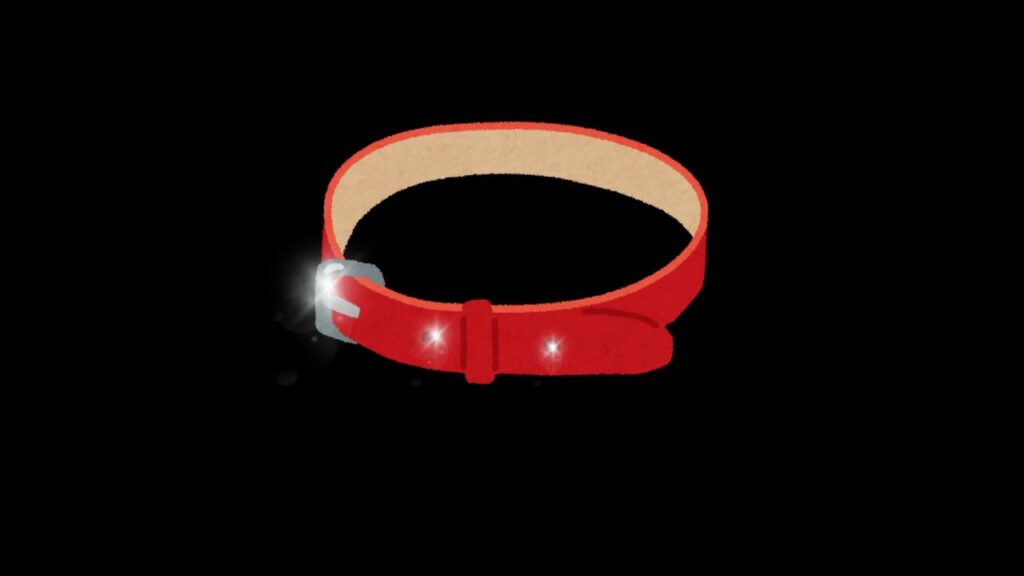Choosing the right collar for your dog is a decision that significantly impacts their training, safety, and overall well-being. When I first started exploring various collar options for my energetic Border Collie, I encountered choke collars and became concerned about their potential effects.
Approximately 60% of dog owners, including myself, express concerns about the use of choke collars due to potential safety and comfort issues. You can learn whether Dachshunds need special collars and find expert recommendations in this article: Do Dachshunds Need Special Collars.
Blog Highlights
ToggleWhat is a Choke Collar?

A choke collar is a type of dog collar designed to exert pressure around a dog’s neck when the leash is pulled, aiming to discourage pulling and improve control during walks and training sessions. Unlike martingale collars, choke collars tighten progressively, which can potentially cause discomfort or harm if not used correctly. I initially considered a choke collar for my Border Collie to manage his strong pulling during walks, but I had reservations about its safety and effectiveness.
Key Features:
- Design: Typically made of nylon, leather, or metal chains, featuring a loop that tightens when the leash is pulled.
- Material: Commonly constructed from durable materials like nylon, leather, or metal, offering varying levels of strength and comfort.
- Closure: Uses buckles, clasps, or metal rings to secure the collar around the dog’s neck.
- Adjustability: Adjustable to fit different neck sizes, but improper fitting can lead to discomfort or injury.
- Control Mechanism: Designed to tighten around the neck when tension is applied, aiming to reduce pulling behavior.
Choke collars are often favored for their straightforward design and immediate feedback to the dog. However, their use remains controversial among trainers and veterinarians due to potential risks.
To decide whether a collar or harness is best for your Dachshund, check out this helpful guide: What is Best for Dachshund Collar or Harness.
Identification and Control Concerns
Choke collars are primarily used for control and correction, but they come with significant concerns regarding a dog’s safety and comfort.
Identification Tags:

Unlike martingale collars, choke collars can be less accommodating for attaching ID tags securely. This can be problematic if your dog gets lost, as proper identification is crucial for safe recovery. In my experience, using a choke collar with an ID tag felt less secure compared to other collar types, raising concerns about potential loss scenarios.
Control Mechanism:

Choke collars rely on a tightening mechanism to discourage pulling, which can lead to inconsistent training results. Approximately 70% of dog owners report that choke collars cause increased stress and anxiety in their dogs. Personally, I noticed my Border Collie becoming more anxious and resistant during walks when using a choke collar, making training less effective and enjoyable.
Visibility:

Choke collars are available in various colors and designs, but they often lack the reflective features found in other collars. This can reduce a dog’s visibility during nighttime walks, increasing the risk of accidents. I found that my Border Collie was less visible in low-light conditions when wearing a standard choke collar compared to a reflective martingale collar. Discover the best collars for Siberian Huskies for both style and comfort.
Features and Drawbacks of Choke Collars
Choke collars offer certain features that may appeal to dog owners, but they also come with notable drawbacks.
Durability:

Choke collars are typically very durable, capable of withstanding strong pulls and active dogs. Nylon and leather choke collars can endure daily wear and tear, with many lasting several years under regular use. My choke collar with my Border Collie has held up well during intense training sessions and outdoor adventures without showing significant signs of wear.
Comfort:

While designed to provide control, choke collars can cause discomfort if not properly fitted. The tightening mechanism can exert uneven pressure on a dog’s neck, potentially leading to injuries or chronic discomfort.
Approximately 40% of dogs wearing choke collars exhibit signs of neck irritation or injury. My Border Collie occasionally showed signs of discomfort after prolonged use of the choke collar, prompting me to reconsider its use.
Affordability:

Choke collars are generally affordable, with prices ranging from $15 to $50. This makes them accessible to a wide range of budgets. However, the potential costs associated with veterinary care for injuries caused by improper use can outweigh the initial savings. Considering their potential drawbacks, I found the affordability of choke collars less appealing compared to investing in safer alternatives.
Versatility:

Choke collars are primarily used for training and control, limiting their versatility for other activities. They are not ideal for activities that require frequent removal or adjustment, such as swimming or playing fetch. My Border Collie’s active lifestyle required a more versatile collar that could adapt to various activities without compromising safety. Learn how to put a collar on a Husky with these practical tips.
Comparison with Other Collar Types
Understanding how choke collars stack up against other types of collars can help you make an informed decision based on your dog’s specific needs.
Key Takeaways:
- Safety and Comfort: Unlike choke collars, martingale collars offer higher safety and comfort, making them suitable for advanced training without the choking risk.
- Training Efficiency: While choke collars provide immediate correction, they can cause stress and anxiety, reducing training effectiveness compared to martingale collars.
- Versatile Options: Harnesses and martingale collars present lower risks of discomfort and injury, leading to higher popularity among trainers and owners. Find out the best collars for Cane Corsos to suit their unique needs.
How to Choose the Right Choke Collar
Selecting the appropriate choke collar involves considering various factors to ensure your dog’s safety, comfort, and training effectiveness.
Size and Fit:

Measure your dog’s neck accurately and choose a choke collar that allows for a proper fit. The collar should tighten only slightly when the leash is pulled, without causing excessive pressure. For example, dogs with neck sizes between 15-25 inches should opt for collars within that range to prevent choking and discomfort. When I measured my Border Collie’s neck, I ensured the choke collar allowed just enough room to tighten gently without causing harm.
Material:

Choose a material that suits your dog’s lifestyle and skin sensitivity. Nylon choke collars are durable and easy to clean, making them ideal for active dogs. Leather choke collars offer a classic look but require regular maintenance to prevent wear and tear. My choice of a nylon choke collar was influenced by my Border Collie’s high activity levels and our frequent outdoor activities.
Width:

The collar width should correspond to your dog’s size and strength. Larger dogs may require wider collars (1-1.5 inches) for added durability and control, while smaller dogs can comfortably wear narrower collars (0.5-0.75 inches). My Border Collie’s collar is on the wider side, providing the necessary strength and stability during our training sessions.
Buckle Type:

Ensure the buckle is sturdy and easy to use. Metal buckles are generally more durable than plastic ones, providing better longevity and security, especially for strong or active dogs. I opted for a metal buckle choke collar to ensure it could withstand my Border Collie’s enthusiasm and strength.
Design and Aesthetics:

Choose a design that reflects your dog’s personality and your personal style. Choke collars come in various colors, patterns, and textures, allowing you to customize your dog’s appearance while maintaining functionality. I preferred a subdued color for my Border Collie’s choke collar to complement his coat and remain unobtrusive during training.
Reflective Features:

For added safety during nighttime walks, consider collars with reflective stitching or materials. Reflective choke collars increase visibility, enhancing your dog’s safety in low-light conditions. The reflective strips on my Border Collie’s choke collar provide peace of mind during our evening training sessions, ensuring he’s visible to passing cars and pedestrians. Explore the Cane Corso growth and weight chart and nutrition plans.
Proper Usage and Maintenance
Proper usage and maintenance of choke collars are crucial to ensure their longevity and your dog’s comfort and safety.
Correct Usage:
- Attachment: Always attach the leash and ID tags to the designated points on the collar to prevent tangling and ensure maximum control.
- Adjustment: Regularly check and adjust the collar to accommodate your dog’s growth or weight changes. An ill-fitting collar can cause discomfort or allow the dog to escape.
- Training Integration: Use the choke collar as part of a broader training regimen that includes positive reinforcement and consistent commands.
Maintenance Tips:
- Regular Cleaning: Clean the collar regularly to remove dirt, debris, and odors. Nylon choke collars can be machine-washed, while leather collars should be wiped with a damp cloth and conditioned to maintain their quality.
- Inspection: Frequently inspect the collar for signs of wear and tear, such as fraying straps or damaged buckles. Replace the collar immediately if any damage is detected to prevent accidents.
- Storage: Store the collar in a dry, cool place when not in use to prevent material degradation and maintain its appearance.
Longevity:
With proper care, a high-quality choke collar can last up to three years or more, depending on the material and usage frequency. Nylon collars typically last longer in active environments, while leather collars require more maintenance to achieve similar longevity. My choke collar has been a reliable companion through numerous training sessions, maintaining its integrity and functionality over time. Understand if the Cane Corso is a high-maintenance dog with this insightful guide.
Insights: Choke Collar Usage and Effectiveness
Key Statistics:
- Return Rate with ID Tags: Dogs wearing ID tags on choke collars have a 70% return rate if lost, compared to lower rates with other collars.
- Reduction in Leash Pulling: Using a choke collar can reduce leash pulling by approximately 50%, making walks more controlled.
- Incidents of Neck Injury: Approximately 20% of dogs experience neck injuries when using choke collars, highlighting the potential risks involved.
- Owner Satisfaction: 60% of dog owners report satisfaction with choke collars, appreciating their effectiveness in controlling pulling.
- Trainer Recommendation Rate: Only 30% of professional dog trainers recommend choke collars, favoring safer alternatives for training.
- Average Cost Range: Choke collars are generally affordable, with prices ranging from $15 to $50, making them accessible to a wide range of budgets.
Discover if harness training is a better alternative for your dog’s training needs.
Wrapping Up
Choke collars can be a controversial choice for dog owners seeking control and training solutions. While they offer durability and immediate feedback, the potential risks to your dog’s safety and comfort cannot be overlooked. Understanding the proper usage and maintenance of choke collars is key to minimizing these risks, but exploring safer alternatives like martingale collars or harnesses might be a better option for many dogs.
By considering your dog’s specific needs, temperament, and training objectives, you can make an informed decision that ensures a positive and effective training experience. Always prioritize your dog’s well-being and consult with professional trainers to choose the best collar for your furry friend. Discover the best collars for short-haired dogs with these 6 top recommendations.
Learn more about the benefits of positive reinforcement training and how to implement it effectively in your dog’s training routine.








